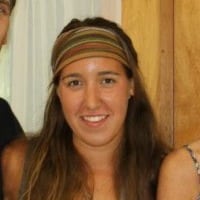The first time I tried calling, I hung up the phone after 10 or so rings. I could have stayed on the line longer, but I was told that, if he didn’t answer the phone, the man I was trying to reach would probably be somewhere outside, roaming the Montana mountain that butts up to his house or working somewhere on his acres of property. I’d have to try again later.
From what I had heard, Bob Hayes was 88 years old (89–he corrected me when I finally spoke with him) and did not have an email address or any other way to electronically contact him.
From what I had Googled, I learned a good deal more. My search brought up articles from Montana newspapers, blog posts from other runners, and an article from Trail Runner Magazine, stories largely about a man defying aging to run lots of miles and work the land in traditional style.
Well, thanks, Meghan [Hicks], I thought to myself of my editor’s assignment to write about Bob. This guy is already a well-known runner! What more can I say about him?
I spent an hour on the phone with Bob last Tuesday night. Listening to him, I found myself laughing at his abundance of running stories and nodding along to the synopsis of the current book he is reading. Okay, Meghan. You’re right. In just that short time I had learned, This guy is cool and there is more to his story than we will ever know.
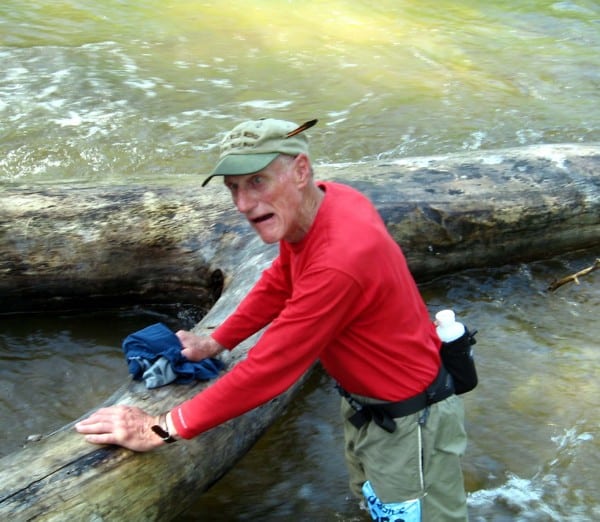
Bob resting in a creek. All photos courtesy of Tom Hayes unless otherwise noted.
According to Tom Hayes, one of Bob’s children, the best window to call his father is between 5 and 7 p.m. on a weekday. Tom said I might catch him then, if he’s not walking the dogs or making dinner.
I gave it another shot. After a few rings, he answered. “Yeah?”
Apparently the answering machine had not been working, and I was lucky and reached Bob just before he took out his two 14-year-old Cairn Terriers, Poni and Jack. I dove into the questions, and he fired right back with his answers, all stories about his journey to where he is now: an 89-year-old runner who enjoys each day on the trails and mountains.
Bob hasn’t always been a runner. In fact, he became one less than 30 years ago. One might say that there were more pressing life matters to tackle first. He was born in Vermont in 1926. After high school, he enlisted and served in World War II. In 1953, he graduated from the Forestry Department at the University of Montana, and for the next 40 or so years, he worked outside, “cruising timber” for lumber companies. Timber cruising meant hiking through a forest, examining and measuring trees. Cruising up and down mountains every day, Bob said, kept him in pretty good shape.
The Evaro Community Center, located where Bob lives in Evaro, Montana, a short drive north of Missoula, was to be transformed from an old town schoolhouse into a local community center and needed renovations to preserve the structure. So, a bunch of community members decided to put on a race, the Evaro Mountain Challenge, to raise money. “In 1981, maybe ’86, was when we put on the [first] race,” he told me. Bob and the rest of the leaders had no idea who or how many people would come, so he decided to run the entire race himself. “I liked it so well, I just kept running,” he said.
When Bob became a runner at that race, which was actually held in 1987, he had already entered the seventh decade of his life. After it, Bob stuck with racing 5k’s and 10k’s for about the next decade.
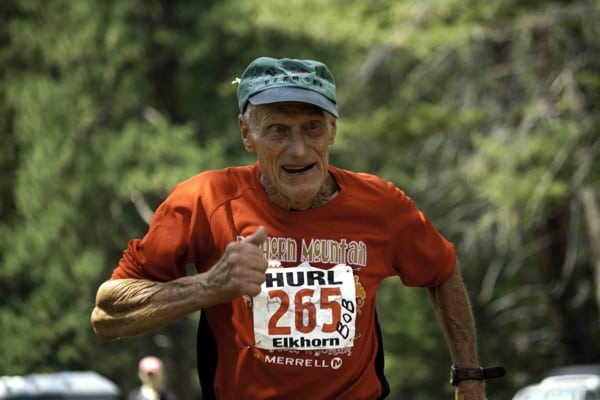
Bob finishing the HURL Elkhorn Endurance Run.
His first ultramarathon was in 1995, when he was 68 years old, the Bighorn Mountain Wild and Scenic 50 Mile Trail Run in Wyoming. For a few years after that, 50ks and 50 milers were interspersed in his running calendar, but every fall he read in the paper about the same guy winning a 100k in Helena. “I thought to myself, I wonder if I could do that?” he said. It was the extra distance that Bob was curious about. “I signed up and began training.”
His wife, Ann, was not as positive about his crazy idea. At first. “She said I was out of my mind,” he laughed. “She said I would never be able to finish, and she didn’t want to see me in an ambulance.” He trained for three months, decided he felt okay, and headed to the race. Ann tagged along, he said, saying she couldn’t stand not seeing how this was going to go. In Bob’s words, he did okay and finished in a decent time.
The year was 2000. Bob was on the cusp of his 74th birthday. His 100k finish time was 14 hours and 11 minutes. He was classed into the “Super Duper Masters” category. It seems like he ran just a bit better than “okay.”
In the coming years, that race was renamed the HURL Elkhorn Endurance Runs, and 50-mile, 50k, and 23k races were offered instead of a 100k. The race is now a popular part of the Montana trail running calendar. Bob went on to complete either HURL’s 50-mile or 50k distances six more times. Bob also continued running marathons, half-marathons, and local shorter-distance races. And other 50ks, 50 milers, and 100ks. More of everything running.
By then, Ann was on board with the whole running thing, and the two trained and raced together up until she fell sick in 2006. He and Ann were told by the doctors she only had about six months to live before she would have an aortic aneurysm burst in her chest. “[The doctor] told me she would have the aneurysm and then would die within a few minutes,” Bob said. Bob took care of his wife until the day came when he watched Ann pass away without being able to do anything to help her.
“I didn’t know what I was going to do then,” he said of his new life alone. “They say the survivor of a spouse who dies would only live two to three years later,” he said. “So, I was reconciled with the fact I would live not much longer.” New Years Eve of that year, 2007, changed his mindset. Bob went to a party for the holiday at the University of Montana where he watched a group of square dancers perform in the school’s ballroom. The woman who had been teaching Bob calligraphy lessons was one of the dancers, and she convinced him to be her dance partner.

Running the Missoula Marathon.
She told him about the local Missoula town dances that were held twice a month. There, they do more contra-dancing style, which is still similar to square dancing. It was during a dance when he met Georgia Cobbs, who is now in her fifties and a professor at the University of Montana. Georgia quickly changed from being his dance buddy to trail-running partner.
“She saw the t-shirts I would wear after coming back from a race, and said, ‘Why don’t I meet you and do a trail run?’” he said. “We went up a really steep hill and I thought she would surely stop, but she didn’t.” Georgia had no water or food when the two reached the top, so Bob shared his goods and then told her they were running back down the other side. “She seemed to enjoy it so I told her there was a race that weekend in Missoula,” he said.
On the weekend, if there is a local race, Bob is usually there running. And, he’s usually the oldest one with a race bib on. He normally sticks to races within a reasonable distance of home, yet there are instances in which he leaves the West to run in new places. He ran the Across the Bay 10k in Chesapeake Bay. While warming up, a newspaper reporter jogged up to the stretching runner and said. “You’re Bob Hayes, right?” The reporter continued, “There are 17,500 runners and you are the oldest runner, did you know that?” Bob gave him the truth. “No I didn’t.” Before the race even began, Bob answered the reporter’s questions about ever being in Baltimore. “’Yes, I was here for WWII,’” he responded. “’We left for Italy from here.’”
After the race, instead of a boat to Italy, he hopped back on the plane and headed back to his retired life in Montana. “I tell everyone that I went down, put my running clothes on in Baltimore, ran the race, came back at midnight, and took my clothes off,” he laughed.
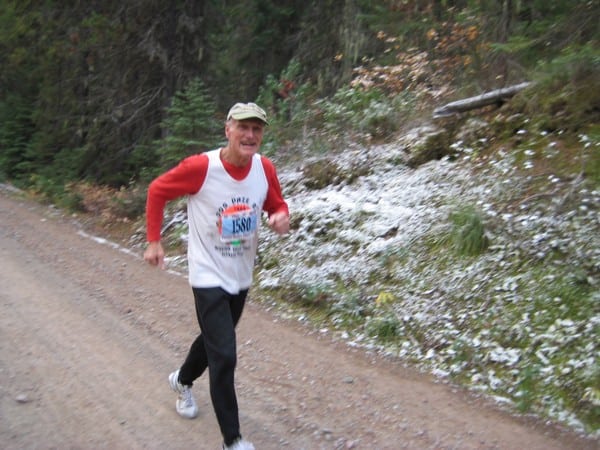
Running Le Grizz Ultramarathon.
Because he races so frequently, Bob’s pile of race shirts is enormous and constantly growing. “I [race] every weekend,” he confirmed. “I ran 30 races last year.” “He only wears race shirts,” Georgia claimed. “When he ‘dresses’ up, it means a clean race shirt.” Bob reads the list of the local races coming once a week in the town newspaper. This year, he said that his number of races would be lower due to a recent injury. Lower, as in 20 to 25, not 30.
It was going to be his 15th race of this year at the 50k in Bighorn, but a problem with his bladder left him having to drop and spend the last few months recuperating. That was in June, and since then he has only run two to three races, he said.
Bob’s raced something like 30 50 milers, about 10 100k’s, and an unknown tally of 50k’s. You could probably only figure the actual number by counting race shirts in his collection.
“The Boy,” as he calls his oldest son, Tom, signed him up for first 100 miler, one in the steep mountains of Utah. They both started the race. For Bob, darkness hit around 45 miles in, while at an aid station where he was able to see his wife for the first time. “I really wish you would stop and start again in the morning,” she had told him.
Already not feeling great, he heeded her advice to stop and he when returned in the morning, it was not to finish his own race–he DNFed that–but to instead help Tom finish the last 25 miles of his race. “[Tom] wanted to drop out, but I said, ‘Stop and sleep and then finish,’” he said. “He did finish and he did okay.” Bob never looked at the distance of 100 miles again. “Yeah, I started only one and don’t plan on doing it again.”
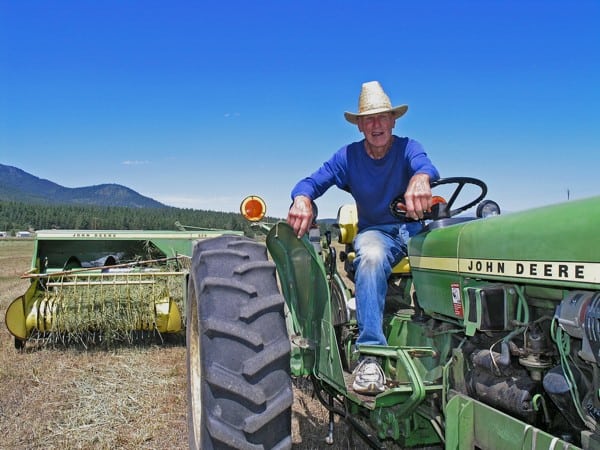
Sitting on his tractor. Photo: Kip Sikora
The Bighorn races in Wyoming are a regular tradition for Bob. He and a buddy, he said, make it more than just an annual race. “On the way back, we stop at the George Armstrong Custer Battlefield,” he said. The park is called the Little Bighorn Battlefield [and it’s] located off the Little Bighorn River in Montana Territory. “It looks the same as when [Custer] fought there. There is a museum we go to, visit the markers, and tour the field. Then we come home. It is always a nice trip.”
The runner’s routine over the years remains near constant. The trail behind his house runs along a steep mountain, and loops back around for a nice seven miler. He meets up with Georgia several times a week to jump on their usual course of eight miles.
In snow, rain, or way, way below what I would consider cold temperatures, Bob heads out in a few layers and the same pair of running shoes he’s had for, he claims, the last five years. “Georgia will tell me she will run the next day only if it is not raining or snowing,” he told me. “Even if it is, I still drive down to her house, and we head out.” That’s true, Georgia said. “I left a message that I couldn’t run one morning,” she said, “and he showed up because he never checked his messages.”
I also had to confirm with Georgia one other thing while I had her on the phone. “Okay, I have to ask,” I said. “The shoes, are they really five years old?” “Oh easily,” she responded, laughing a little. “He is so frugal. One time he showed up to run in blue jeans and I asked him, ‘Bob, why are you wearing blue jeans?’” “My tights are in the wash,” he told her.
Including whatever race might be happening on the weekend, Bob runs between 40 and 50 miles in an average week. “It depends on if I am training for a 50k or marathon,” he said. “I start out with 30 or 40 miles, then will work up.”
He will go out one day and run 50 miles with Georgia or on his own, then won’t go out again for the next 10 days to recover. “Those younger athletes can run 40 miles a day, but when you get older you have to recover and rest,” he said.
Retired and living with two dogs, Bob said it could get lonely. The dogs and his other son and his wife, who have the neighboring house, definitely help combat that. And then there is the incomparable local running community.
“Racing is very social,” he said. “You know all these runners and have seen them sign up before, so you socialize with them.” Bob doesn’t have a T.V. or internet or any of the modern means most people use to keep in touch these days, so he and other local runners know each other, almost exclusively, through these in-person meetings at races. Yet Bob remains a focal point of his local running world, maybe a testament to the power that our sport has to create real-life connections.
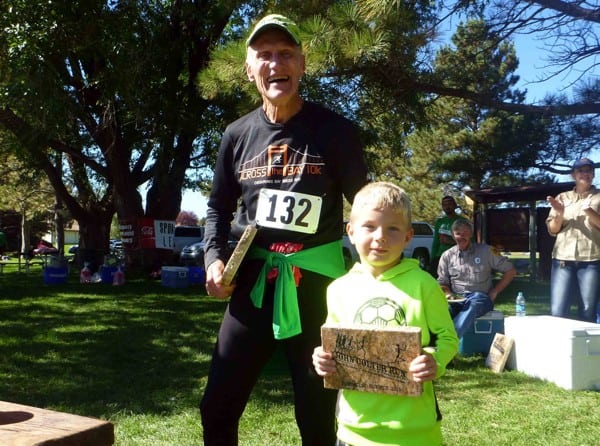
Bob and family friend, Mason. The two were the oldest and the youngest runners at the John Colter Run in September, 2015.
For the majority of runners, aging and running are mutually exclusive entities. More like, the former usually precludes the latter. In part because Bob’s progression is atypical, he has received a fairly heavy dose of recent inquiries from the media, from Trail Runner Magazine, iRunFar.com, someone else who is writing another piece on him, and students from the University of Montana School of Journalism who are making a documentary about him called ‘The Hard Way.’ When asked about this attention, he chuckles and says, “People tell stories about you, and you never know if they’re true, right?”
During the day, Bob rarely sits inside. Instead he works through his 180 acres of fields, timberland, and pasture, processing firewood, raising a few animals, and laying out hay. “There is always something to be doing,” he reminded me. When finally indoors, the house stays quiet, except for cooking meals and turning the pages on the latest history novel he’s picked up. While he read about a rebellion in Canada on the day we talked, outside the weather dropped three to four inches of snow and the temperature to around 20 degrees Fahrenheit.
In the morning, despite the fall storm, he has plans to meet Georgia and the four-legged partners for a few miles. This weekend may not have a race scheduled, but Bob doesn’t mind. He will run, work outside, read, and spend time with his dogs and family.
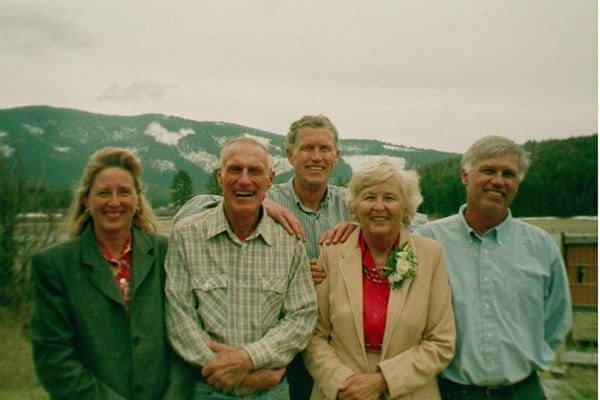
Bob and his wife, Ann, with their three children at their 50th wedding anniversary. From left to right is Suzanne, Bob, Tom, Ann, and Andy.
Looking ahead, this time he doesn’t need the local paper to know his next race. On Thanksgiving every year, he travels to Bozeman, about 250 miles from Missoula. He runs hard with the other 3,000 or so people signed up for the 5k or 10k distances at Huffing for Stuffing. Then, like many will do that day, he will pig out on dinner with friends in the area.
In talking with Bob, I’ve realized that he has a story for each of his races and runs, and that each one is worth hearing. But you’ll only find a small selection of them remotely available, in articles like this. And, like me, you’d probably also have poor luck in catching him at a moment where he’s inside and free to answer the phone. So, to hear one of Bob’s stories, it’s probably best for you to don your running clothes and meet him at a race.
“I just like running,” he stated.
He is the icon of Missoula running, Georgia claimed. “He runs to live or lives to run,” she said. “When he stops, he will be dead. I hope that is well into his hundreds, for me and for the community.”
